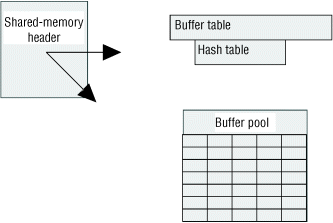Buffer pool portion of shared memory
The buffer pool portion of shared memory contains the buffers that store dbspace pages that are read from disk.

You use the BUFFERPOOL configuration parameter to specify information about a buffer pool, including the number of buffers in the buffer pool or the overall size of the buffer pool. Each buffer is the size of one database server page. Too few buffers can severely affect performance. You can set the BUFFERPOOL configuration parameter to allow the database server to automatically increase the number of buffers as needed to improve performance. Otherwise, you must monitor the database server and tune the number of buffers to determine an acceptable value.
A buffer pool manages one size of pages. You need a different buffer pool for each page size that is used by storage spaces in the database server. The database server automatically creates the required buffer pools. For example, if you create the first dbspace that has a page size of 6 KB, the database server creates a buffer pool to cache the default number of 6 KB pages in memory. You can control the properties of buffer pools with the BUFFERPOOL configuration parameter.
If the database server is in online, quiescent, or administration mode, you can also use the onparams -b command to add a buffer pool of a different size. When you use the onparams -b command, the information that you specify is transferred automatically to the onconfig file as a new entry of the BUFFERPOOL configuration parameter.
In general, the database server performs I/O in full-page units, the size of a buffer. The exceptions are I/O performed from big buffers, from blobspace buffers, or from lightweight I/O buffers.
Automatic LRU (least recently used) tuning affects all buffer pools and adjusts the lru_min_dirty and lru_max_dirty values that can be explicitly set by the BUFFERPOOL configuration parameter.
The status of the buffers is tracked through the buffer table. Within shared memory, buffers are organized into FIFO/LRU buffer queues. Buffer acquisition is managed by mutexes and lock-access information.
The onstat -b command shows information about the buffers.